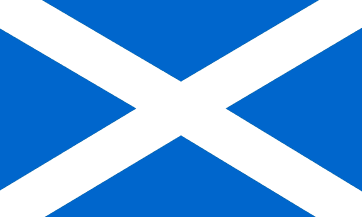|
Saturday 8 September 2007
We drive to Portree the main town on Skye. Our
first stop is at Kilt Rock Falls. A nice waterfall plunging a couple of hundred
feet down into the sea. The cliffs are almost vertical here and the coast quite
spectacular. On the other side of the water we see the island of 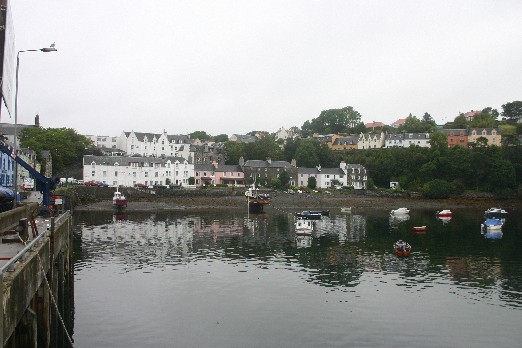 Raasay.
Once past the falls the road narrows to one lane, with every 50 yards or so a
passing place. Drivers are very polite here and wait for each other and wave by
way of thanks. Portree, with its 2000 inhabitants is not a big place either.
Still it is an attractive fisher harbour with a colourful port which falls dry
at low tide. We have a coffee at Arriba café with a view on the harbour.
After exploring Portree for a bit, we drive on to Glen Brittle, where we
plan to do some walking. First we stop for lunch at
The Old Inn
in the hamlet of Carbost. The Inn is superbly located on the shores of Loch Harport
and offers views of the Cuillin Mountains, the most known mountain range
on the Island and popular among mountain walkers. Unfortunately the mountains
are covered by low clouds that shed some rain every now and then. The roads to Glen
Brittle are narrow single lane and beautiful. The Glen Brittle valley is very
quiet. No villages at all. Raasay.
Once past the falls the road narrows to one lane, with every 50 yards or so a
passing place. Drivers are very polite here and wait for each other and wave by
way of thanks. Portree, with its 2000 inhabitants is not a big place either.
Still it is an attractive fisher harbour with a colourful port which falls dry
at low tide. We have a coffee at Arriba café with a view on the harbour.
After exploring Portree for a bit, we drive on to Glen Brittle, where we
plan to do some walking. First we stop for lunch at
The Old Inn
in the hamlet of Carbost. The Inn is superbly located on the shores of Loch Harport
and offers views of the Cuillin Mountains, the most known mountain range
on the Island and popular among mountain walkers. Unfortunately the mountains
are covered by low clouds that shed some rain every now and then. The roads to Glen
Brittle are narrow single lane and beautiful. The Glen Brittle valley is very
quiet. No villages at all. 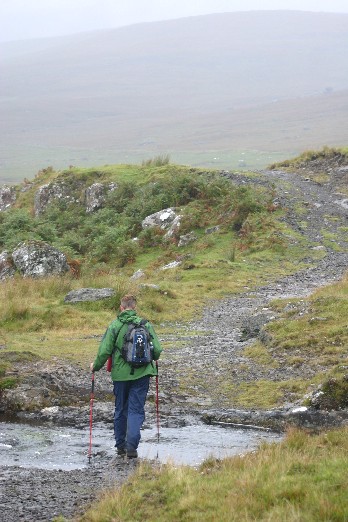 The
only thing we pass is a training centre for sheep dogs. At the end of the Glen
we arrive at a beach and a small camp site. That is where we start our walk. We
keep the Cuillins to our left and the sea to our right. We have to cross a
couple of streams, only once with help of a bridge. Here and there we see sheep,
who can graze here freely all summer long. After an hour and a half the walk
loops back and via a parallel track on a slightly higher level we walk back to
our starting point. After the walk we hit the road again, this time following
the West Coast of the island towards the north. The sky is clearing and for the
first time today we can see the highest mountain tops or Munroes. Munro
is typical Scots word. Like Eskimos have many words for snow, for the Scots a
hill is rarely just a hill. Depending on where you are, what it looks like and
how high it is a hill can be a Hill, a Ben, a Mount, a Law,
a Pen, a Brae or even a Pap. Munroes are mountain
tops in Scotland of 3000 feet or higher. These tops have been listed for the
first time by Sir Hugh Munro in 1891. They are 284 in total. Munro bagging is
a term for collecting
Munroes by mountain hikers. Beside Munroes there are also Corbetts
(2500-2999 ft) and even Donalds (lowland hills over 2000 ft). The
only thing we pass is a training centre for sheep dogs. At the end of the Glen
we arrive at a beach and a small camp site. That is where we start our walk. We
keep the Cuillins to our left and the sea to our right. We have to cross a
couple of streams, only once with help of a bridge. Here and there we see sheep,
who can graze here freely all summer long. After an hour and a half the walk
loops back and via a parallel track on a slightly higher level we walk back to
our starting point. After the walk we hit the road again, this time following
the West Coast of the island towards the north. The sky is clearing and for the
first time today we can see the highest mountain tops or Munroes. Munro
is typical Scots word. Like Eskimos have many words for snow, for the Scots a
hill is rarely just a hill. Depending on where you are, what it looks like and
how high it is a hill can be a Hill, a Ben, a Mount, a Law,
a Pen, a Brae or even a Pap. Munroes are mountain
tops in Scotland of 3000 feet or higher. These tops have been listed for the
first time by Sir Hugh Munro in 1891. They are 284 in total. Munro bagging is
a term for collecting
Munroes by mountain hikers. Beside Munroes there are also Corbetts
(2500-2999 ft) and even Donalds (lowland hills over 2000 ft).
Atj Dunvegan we turn right towards Portree. Via
Portree we drive north towards the Trotternish peninsula where
Staffin can be found. Here to the sky is clear and the sun makes an apearance. We
see the Old
man of Storr a remarkable rock, that is now free from fog and easy to see.
At night we have dinner at the Glenview hotel in Culnacnoc, almost 7 km
south of Staffin. The owners do their very best and the food is fine.
Weer: zwaar bewolkt. Af en toe regen. Laat in de middag
klaart het op en schijnt de zon. 14 graden
Zondag 9 september 2007
Staffin - Fort William 200 km /
125mi
After breakfast we drive via Portree to the southern tip
of the island, which we leave via the Skye bridge. The bridge was
finished in 1995 and cost many millions of pounds. The ferry service between Kyle of Localsh
and Kyleakin was stopped. Islanders avoided the high tolls until the Scottish
Executive bought off the tolls. The bridge can now be used for free. 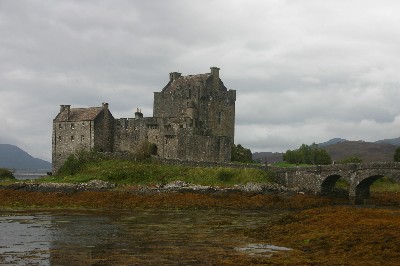 Just
over the bridge is Scotland's most photographed sight: Eilean Donan Castle.
A fairy tale castle, strategically positioned at the confluence of three Lochs.
It was finished in 1230 and the seat of the McCrae family until it got involved
in the Jacobite rebellion in 1719. It offered shelter for a Spanish garrison
sent to help James Stuart against King George in his effort to reclaim the
Scottish throne. The king had the castle destroyed. In 1912 John McCrae-Gilstrap
had the castle rebuilt to its former glory. It is now open to the public and its
restoration is very good. Unfortunately it is a bit too popular a destination.
Photography is not allowed inside and there are guides in all the main rooms
dressed in kilts. The castle was the decor for a number of Hollywood movies like Highlander, Entrapment
(both starring Sean Connery) and The World is Not Enough (starring Pierce Brosnan
as James Bond). We drive though magnificent Glens via
Invergarry to Fort William and stop briefly at the Commandos memorial. An
impressive monument to the memory of the commando troops who trained here during
World War II. The monument is on a hill top, but the view is spoilt by the bad
weather. In Fort
William it is dry and we are staying in the Alexandra
hotel, an old world hotel, kept in reasonably good shape. There is a World
Championship going on in Mountain Biking, which is why our hotel is full of
mountain bikers. Our floor looks like a bike repair workshop. Just
over the bridge is Scotland's most photographed sight: Eilean Donan Castle.
A fairy tale castle, strategically positioned at the confluence of three Lochs.
It was finished in 1230 and the seat of the McCrae family until it got involved
in the Jacobite rebellion in 1719. It offered shelter for a Spanish garrison
sent to help James Stuart against King George in his effort to reclaim the
Scottish throne. The king had the castle destroyed. In 1912 John McCrae-Gilstrap
had the castle rebuilt to its former glory. It is now open to the public and its
restoration is very good. Unfortunately it is a bit too popular a destination.
Photography is not allowed inside and there are guides in all the main rooms
dressed in kilts. The castle was the decor for a number of Hollywood movies like Highlander, Entrapment
(both starring Sean Connery) and The World is Not Enough (starring Pierce Brosnan
as James Bond). We drive though magnificent Glens via
Invergarry to Fort William and stop briefly at the Commandos memorial. An
impressive monument to the memory of the commando troops who trained here during
World War II. The monument is on a hill top, but the view is spoilt by the bad
weather. In Fort
William it is dry and we are staying in the Alexandra
hotel, an old world hotel, kept in reasonably good shape. There is a World
Championship going on in Mountain Biking, which is why our hotel is full of
mountain bikers. Our floor looks like a bike repair workshop.
We eat at night at No4 restaurant. Not too bad a place to
eat and not too expensive either.
Weather: long rainy periods, clearing later. 14°C/57°F
Monday 10 September 2007
We have breakfast in the main breakfast room of the hotel.
Separate tables are set for the cycling teams sporting the national flags of
their countries, but the cyclists - one or two excepted - are still vast asleep
in bed. We have to move to a B&B today. It is a nice one too, as it turns
out. It is called The
Grange and it's on the other side of the town centre, with a great view on
Loch Linnhe. We leave our baggage their and go to the station and buy tickets
for the train to Mallaig. It is a beautiful sunny day. Blue skies and no clouds.
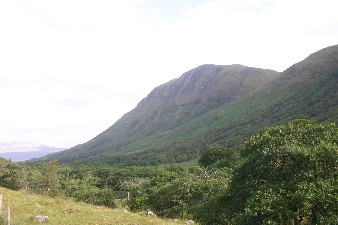 The railway to Maillaig is one of the most scenic in the country. The train will
leave at 12.30, so we have lots of time for other things. We drive to Neptune's staircase,
a series of locks in the Caledonian Canal between Fort William and Inverness.
The Canal was opened in 1822 and connects the Atlantic Ocean and the North Sea.
The canal has 29 locks, 10 bridges and 4 aquaducts and was the first publicly
funded transport system in Britain. Here in the suburb of Banavie there
are five locks bridging 20 metres altitude over half a mile. Unfortunately there
no boats that have to go through, so we cannot see the system in action. The
young lockkeeper tells us that we stand more chance of seeing some action up in Fort Augustus,
but that is more than 30 miles away. We then drive to Glen Nevis, the valley
along Ben Nevis,
The railway to Maillaig is one of the most scenic in the country. The train will
leave at 12.30, so we have lots of time for other things. We drive to Neptune's staircase,
a series of locks in the Caledonian Canal between Fort William and Inverness.
The Canal was opened in 1822 and connects the Atlantic Ocean and the North Sea.
The canal has 29 locks, 10 bridges and 4 aquaducts and was the first publicly
funded transport system in Britain. Here in the suburb of Banavie there
are five locks bridging 20 metres altitude over half a mile. Unfortunately there
no boats that have to go through, so we cannot see the system in action. The
young lockkeeper tells us that we stand more chance of seeing some action up in Fort Augustus,
but that is more than 30 miles away. We then drive to Glen Nevis, the valley
along Ben Nevis, 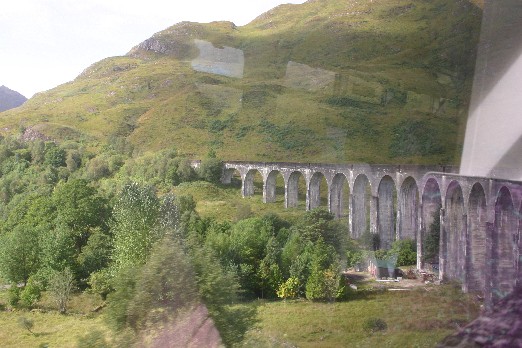 Britain's
highest mountain peak. Here starts the track up to the top. Without a doubt this
is the most popular climb in Scotland, with more than 100,000 people going up
every year. The climb should be treated with some care as the weather can change
at the drop of a hat and snow in the height of summer is not uncommon. It takes
about 8 hours up and back, but we do not do it. We have coffee at Café 115 in
the High Street. Then we are off to the railway station to catch our train to Mallaig via
the West Highland Railway Line. The route is magnificent. It runs past
lakes and mountains, over beautiful railway bridges and finally along the coast
towards the harbour village of Mallaig. We enjoy the scenic train ride which
takes to Mallaig in 1,5 hours. Apart from the three daily scheduled services
by First
Scotrail there is also the Jacobite
Steam Train, running once daily in the summer season, with historic
carriages pulled by a real steam engine. The engine was used in the Harry Potter
movies gebruikt. The historic train costs
£28 return, more than three times the price of the normal train. It is the same
route. Mallaig is a small habour village, without any major attractions. We have
lunch in the Tea Garden and kill time by walking up and down all the streets.
Mallaig is the terminal for the ferries to Skye. At 4.10pm the train returning
to Fort William departs and we arrive there around 5.30. Britain's
highest mountain peak. Here starts the track up to the top. Without a doubt this
is the most popular climb in Scotland, with more than 100,000 people going up
every year. The climb should be treated with some care as the weather can change
at the drop of a hat and snow in the height of summer is not uncommon. It takes
about 8 hours up and back, but we do not do it. We have coffee at Café 115 in
the High Street. Then we are off to the railway station to catch our train to Mallaig via
the West Highland Railway Line. The route is magnificent. It runs past
lakes and mountains, over beautiful railway bridges and finally along the coast
towards the harbour village of Mallaig. We enjoy the scenic train ride which
takes to Mallaig in 1,5 hours. Apart from the three daily scheduled services
by First
Scotrail there is also the Jacobite
Steam Train, running once daily in the summer season, with historic
carriages pulled by a real steam engine. The engine was used in the Harry Potter
movies gebruikt. The historic train costs
£28 return, more than three times the price of the normal train. It is the same
route. Mallaig is a small habour village, without any major attractions. We have
lunch in the Tea Garden and kill time by walking up and down all the streets.
Mallaig is the terminal for the ferries to Skye. At 4.10pm the train returning
to Fort William departs and we arrive there around 5.30.
Our B&B is great. Nice, large room, with en suite bath
and our own terrace with a view on Loch Linnhe. At night we have dinner
in Crannog
restaurant, on the pier. A fine fish restaurant, where I am having haddock and
Erik is taking the salmon, after having sampled the delicious oysters!
Weather: sunny and dry 18°C/64°F
Tuesday 11 September 2007
Fort William - Glasgow 268 km /
168mi
After a great breakfast we say goodbye to the Grange and
head for Glasgow. We drive through GlenCoe, the impressive valley south
east of Fort William. There are low clouds, but here and there the clouds lift
and reveal the sheer beauty of this Glen. The valley has a bloody history,
because it was here that on 13 February 1692 the Campbell clansmen killed 38 to 45 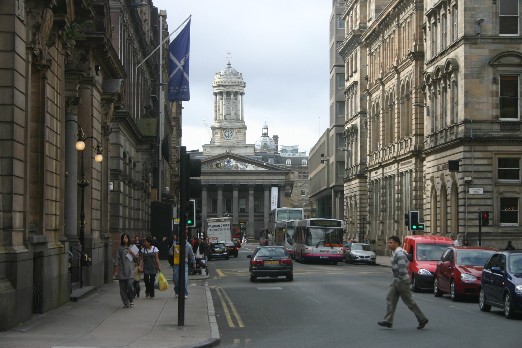 members of the MacDonald clan and chased more than 300 into the mountains, after
they had enjoyed (or abused) their hospitality for more than 10 days. And all
that because the MacDonalds had failed to pledge their allegiance in time to the
Anglo-Dutch king William, who was also king of Scotland. It is quite a drive to
Glasgow, taking us along the western shores of Loch Lomond. Around 12.30
we arrive in Glasgow. We have some difficulty with
the one way system inMerchant City the part of town where our hotel is. We
manage to get there in the end. It is a fine hotel, the Brunswick.
Not large, but trendy with a hip bar at street level. We have to park a few
blocks away in a covered parking lot. The hotel gives us a discount card. After
a break and a lunch in the Brutti ma Buoni café inside the hotel, we take the Underground
(locally called Clockwork Orange) to the Westend. There we walk to the Kelvingrove
Art Gallery & Museum. It was reopened last year and has a varied
collection. The building opened the first time in 1901 and was funded by the
city's merchants in order to offer the Glaswegian of all walks of life the
chance to enjoy culture in the the broadest sense.
members of the MacDonald clan and chased more than 300 into the mountains, after
they had enjoyed (or abused) their hospitality for more than 10 days. And all
that because the MacDonalds had failed to pledge their allegiance in time to the
Anglo-Dutch king William, who was also king of Scotland. It is quite a drive to
Glasgow, taking us along the western shores of Loch Lomond. Around 12.30
we arrive in Glasgow. We have some difficulty with
the one way system inMerchant City the part of town where our hotel is. We
manage to get there in the end. It is a fine hotel, the Brunswick.
Not large, but trendy with a hip bar at street level. We have to park a few
blocks away in a covered parking lot. The hotel gives us a discount card. After
a break and a lunch in the Brutti ma Buoni café inside the hotel, we take the Underground
(locally called Clockwork Orange) to the Westend. There we walk to the Kelvingrove
Art Gallery & Museum. It was reopened last year and has a varied
collection. The building opened the first time in 1901 and was funded by the
city's merchants in order to offer the Glaswegian of all walks of life the
chance to enjoy culture in the the broadest sense.  The collection ranges from stuffed animals, Scottish history to paintings. They
have both a Rembrandt and a Dalí. One section is devoted to the Glasgow Boys
and the Colourists, two strands of Scottish painting related to modernist and
impressionist art in France. The major attraction, however, is the real Spitfire
fighter plan from 1947, suspended from the ceiling in the East Wing. The entry
hall is impressive too, running the whole depth of the building. There is even a
big pipe organ. After the museum we walk to Byre Road the beating heart of
the Westend, a lively student and night life area. We have a drink in
Tennent's bar, a large traditional pub with no less than 9 real ales on tap. On
the way back to the hotel hotel we stop at the Corinthian.
A typical example of the recent developments in Merchant City. The area was
first developed in the 19th century for the trade and financial sector. I
The collection ranges from stuffed animals, Scottish history to paintings. They
have both a Rembrandt and a Dalí. One section is devoted to the Glasgow Boys
and the Colourists, two strands of Scottish painting related to modernist and
impressionist art in France. The major attraction, however, is the real Spitfire
fighter plan from 1947, suspended from the ceiling in the East Wing. The entry
hall is impressive too, running the whole depth of the building. There is even a
big pipe organ. After the museum we walk to Byre Road the beating heart of
the Westend, a lively student and night life area. We have a drink in
Tennent's bar, a large traditional pub with no less than 9 real ales on tap. On
the way back to the hotel hotel we stop at the Corinthian.
A typical example of the recent developments in Merchant City. The area was
first developed in the 19th century for the trade and financial sector. I After World War II, when Glasgow gradually lost its overseas markets, the area
fell into decline. Many of the proud trade and banking houses stood empty for a
couple of decades. In the last ten years or so Glasgow and Merchant City have
made a spectacular recovery. Trendy bars and restaurants, apartments, ICT and creative
companies bring new life into the old buildings. The
Corinthian has 3 bars, a restaurant and 2 clubs in a former bank office
building. The cocktailbar or Lite Bar is on the ground floor where once tellers
counted the money. Despite the huge space and the monumentality of the building,
the carefully designed furniture offers a relatively intimate atmoshere.
After World War II, when Glasgow gradually lost its overseas markets, the area
fell into decline. Many of the proud trade and banking houses stood empty for a
couple of decades. In the last ten years or so Glasgow and Merchant City have
made a spectacular recovery. Trendy bars and restaurants, apartments, ICT and creative
companies bring new life into the old buildings. The
Corinthian has 3 bars, a restaurant and 2 clubs in a former bank office
building. The cocktailbar or Lite Bar is on the ground floor where once tellers
counted the money. Despite the huge space and the monumentality of the building,
the carefully designed furniture offers a relatively intimate atmoshere.
At night we eat at Dhabba,
a trendy modern Northern Indian restaurant. Not your average curry joint, but
classy and carefully prepared food in a relaxed atmosphere. We watch some tv and
then go out to check out the Gay scene, concentrated here in the Merchant City
right at the doorstep of our hotel.
Weather: dry and overcast. 17°C/63°F.
|
